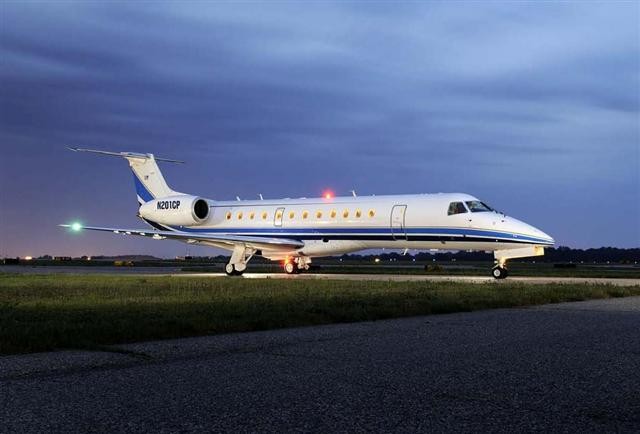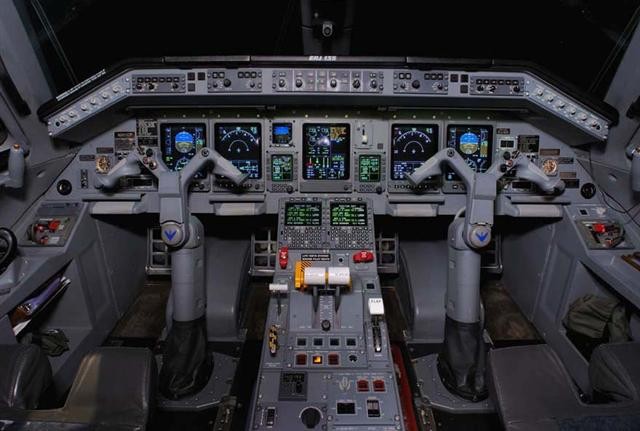


Aircraft Description
The most notable modifications made to the EMB-135 were the addition of winglets (increasing speed and stability), and the addition of several auxiliary fuel tanks (increasing the jet’s fuel capacity from 11,300 pounds to 18,160 pounds). Two years later, Embraer released the EMB-135LR, another model that has fared well since its debut in 2004.
The EMB-135LR, in contrast to its predecessor, is designed to work best on shorter trips. It can carry more passengers than its predecessor, and is designed to be used as a corporate shuttle for anywhere between 16 and 37 passengers, not as a luxurious office at 39,000 feet.
With that in mind, the Legacy Shuttle meets its design objectives very well. It is extremely practical, making it an ideal private jet for day-to-day business use. In addition, it is exceptionally reliable, retaining plenty of backup systems for each key function, as should be expected from a private jet originally designed for day-in, day-out commercial use.
The cabin of the Legacy Shuttle is the second-largest of any heavy jet (following only the late-generation Gulfstreams), with a cabin volume of 1,413 cubic feet. The cabin measures 6 feet high, 6.9 feet wide, and 42.4 feet long. The internal and external baggage compartments, totaling 367 cubic feet, can hold 2,756 pounds of baggage and are both accessible in-flight. The external baggage compartment is pressurized, air-conditioned, and has class C fire protection.
Although the interior configurations vary greatly according to how many passengers the jet holds (16-37 passengers), typical amenities include a galley with an oven, coffee maker and cold food storage. Airshow 400, single-channel satcom and multiple AC power outlets are included in the standard interior configuration. The in-flight entertainment system consists of a 20-inch flat-panel screen mounted at the front of the cabin that includes DVD, VCR, and CD players with headphone jacks at each seat. Alternately, individual passenger screens may be installed, along with multi-channel satcom, various pieces of office equipment, a microwave, and so on. Cabins are insulated with a 54 dBa acoustical insulation package from Flight Environments and all have an emergency oxygen system and an emergency exit. Seat design varies according to which interior layout is chosen; for the 16-passenger option, the seats are quite comfortable and spread out, as in a first-class commercial cabin. The 19-passenger configuration uses smaller seats that are more tightly-spaced, and the high-density (37 passenger) option is undeniably reminiscent of coach.
The Legacy Shuttle is powered by two Rolls-Royce AE3007 A1/3 turbofan engines. Each engine is flat-rated to 7,057 pounds of thrust. Inspection is on-condition. FADEC makes engine startup almost entirely automatic and regulates their performance in-flight for optimal fuel burn and speed. On average, the engines burn 313 gallons of fuel per hour.
Although runway performance is not the Legacy Shuttle’s strong point, its ability to operate with heavy payloads and still fly a decent distance makes up for it. On a sea level runway, the Legacy Shuttle requires 5,449 feet to take off. For a runway at 5,000 feet and a temperature of 77°F, the requirement increases to 6,850 feet. Although its high-altitude takeoff length is longer than the average heavy private jet requirement, the Legacy Shuttle can fly 2,049 nautical miles (Seattle to Boston, for example) after such a takeoff. It would fly this distance by first climbing directly to its long-range cruise altitude of 37,000 feet in 22 minutes, then cruising at 387 ktas (.68 Mach). A high speed cruise of 446 ktas (.77 Mach) can also be achieved at 37,000 feet and will consume about 10% more fuel than at long-range speed. The Legacy Shuttle’s average speed, including climb and descent, is 371 ktas.
The cockpit of the Legacy Shuttle is equipped with the Honeywell Primus 1000 avionics suite, which includes dual FMS with GPS, CVR, TAWS, TCAS, a Primus 800 Doppler Turbulence detection weather radar, single-channel CAT II autopilot, a Smiths Industries Integrated Standby Instrument System, and many more pieces of communication and situation-awareness equipment. Information is displayed on five flat-panel Cathode Ray Tubes. Additional equipment can be added as desired.
In short, the Legacy Shuttle was designed to be a reliable, practical private jet suitable for frequent business use. It can carry large loads and still achieve respectable range. The jet can faithfully complete missions without incident, while its heavy private jet peers are in the shop for maintenance, scheduled or otherwise.
| General | Legacy Shuttle, EMB-135LR | |||
|---|---|---|---|---|
| Category | Jet < 20,000 lbs. | |||
| Years Aircraft Manufactured | 2001 – | |||
| Serial Number Range | 145361 | |||
| Retail High Price | $20,624,000.00 / 16,183,652.80€ | |||
| Retail Low Price | $15,900,000.00 / 12,476,730.00€ | |||
| Characteristics | Legacy Shuttle, EMB-135LR | |||
| Seating | 2+16/37 | |||
| Wing Loading | 80.0 | |||
| Power Loading | 3.1 | |||
| Noise(EPNdB): Takeoff/Sideline/Approach | 79.7/84.5/92.3 | |||
| External Dimensions (ft) | Legacy Shuttle, EMB-135LR | |||
| External Length | 86.4 | |||
| External Height | 22.2 | |||
| External Span | 65.8 | |||
| Internal Dimensions (ft) | Legacy Shuttle, EMB-135LR | |||
| Internal Length (Overall/Net Height) | 53.4/42.4 | |||
| Internal Height | 6.0 | |||
| Internal Width (Max/Floor) | 6.9/5.1 | |||
| Baggage | Legacy Shuttle, EMB-135LR | |||
| External: Cu.Ft./Lb. | 42/551 | |||
| External: Cu.Ft./Lb. | 325/2,205 | |||
| Power | Legacy Shuttle, EMB-135LR | |||
| Engines | 2 RR AE 3007 A1/3 | |||
| Output (lbs ea.)/Flat Rating | 7,057/ISA+30 | |||
| Inspection Interval | OC | |||
| Data based on latest manufactured year | ||||



